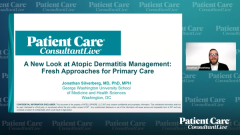
Navigating Appropriate Use of Topical Corticosteroids in Atopic Dermatitis Treatment
A panelist discusses how patients cycling through numerous topical treatments, often without success, signals the need for treatment escalation or specialist referral, while emphasizing the risks and proper use of topical corticosteroids and calcineurin inhibitors in managing chronic dermatological conditions.
Episodes in this series

The speaker introduces the idea of “topical purgatory,” a situation where patients cycle through numerous topical treatments—often unsuccessfully—without escalation in care. When patients present with a suitcase full of failed topicals, especially potent steroids, it’s a signal that more of the same is unlikely to help. At that point, the clinician should consider stepping up treatment or referring to a specialist. The speaker also reinforces that while topical corticosteroids and calcineurin inhibitors are generally safe and effective, they do carry real risks—especially when used long-term on sensitive areas. Examples include skin thinning, bruising, and stretch marks. Though such adverse effects are rare, they can be devastating for the individual affected.
Calcineurin inhibitors carry an FDA boxed warning, but the speaker argues this is largely unsupported by data and was more a regulatory consequence than a scientific one. In practice, they can be very useful steroid-sparing options, especially for areas like the face or neck. The potency of topical steroids should be tailored to the site and severity of the flare: lower potency for delicate skin, higher potency for thicker skin or refractory cases. For many patients, using a stronger steroid briefly is more effective than prolonged use of a weak one. Importantly, patients should often continue treatment for a short time beyond visible improvement to eliminate lingering subclinical inflammation and reduce risk of relapse.
The speaker also cautions against chronic, repeated use of topicals that never fully resolve symptoms—this leads to dependency without progress. For patients with recurrent or chronic flares, strategies like tapering, scheduled “weekend” doses, or switching to long-term nonsteroidals may be needed. The controversial concept of topical steroid withdrawal (TSW) is addressed critically: While some patients may genuinely experience TSW, many so-called cases may actually reflect other issues like irritant reactions, infections, or misuse. A real-life example is given of a patient who used high-potency clobetasol on her eyelids for a year, resulting in true dependence—underscoring the need for clear patient guidance and judicious use of potent steroids.
Newsletter
Enhance your clinical practice with the Patient Care newsletter, offering the latest evidence-based guidelines, diagnostic insights, and treatment strategies for primary care physicians.















































































































































































































































































